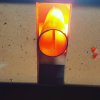I would not mess with any coating at all on the blanket or on the Kanthal. One inch/25mm would be my choice and 8 lb/cu ft/128 kg/m3 density. I'd probably try to use a double wrap of 1400 degC/2600 degF blanket if possible: If you are running an internal temperature of about 1100 degC (2012 degF) and have any sort of temperature gradient through the tube wall, the element seems likely to be significantly hotter than the chamber. I'd not be too upset if the hi-temp blanket is not available where you are. Either the 1260 degC/2300 degF Ceramic fibre or, if nothing else is available, the 1200 degC Low-Body-Persistence Aluminium Silicate should work OK. The higher-temperature stuff just gives a margin for comfort. In the UK, the LBP stuff is about all we can get in less than full box quantities.
I don't know your preferred construction method, but I'd probably keep wrapping the blanket until I had a snug fit into a 6" thinwall pipe or duct, cut off the excess and just shove it in.
Coatings for blanket are mainly recommended to immobilize the fibres for safety. You'll have the tube for that. ITC100 is usually recommended as a high-emissivity coating to improve radiant heating and is expensive. In this case, you are going to be using conductive heat transfer from the element to the tube, so the radiative properties do not really matter. Spend the money on something else that might actually help the design to work better. I would rigidize the blanket where it protrudes beyond the tube, if indeed it does protrude, if only to stop it flopping about and getting in the way when putting blades in and out.
The PID controllers I use on my ovens are either Omega CN7823 or Automation Direct Solo 4848VR controllers. As far as I can tell, they are exactly the same controller with different badges and I buy whichever is cheapest at the time. They have ramp/soak capability. Both Omega and AD have international distributors and, IME, excellent technical support. The Auber Instruments SYL-2352P controller seems popular in the US and has ramp/soak capability, though I have not used it myself because Auber do not have a UK presence. Any industrial ramp/soak controller will be a LOT less easy to program for the ramp/soak profiles than any of the ramp/soak controllers supplied by the commercial kiln manufacturers. Those are specifically intended for use by the end-user and considerable expense goes into making them easy to use. I looked into aftermarket kiln controllers a few years ago and could not find any that offered a 2-second output cycle, which my testing showed was needed for a stable output with my ovens, so settled on the AD SL4848VR and Omega CN7823. Current US prices are $134 for the Omega, $104 for the AD and $79 for the Auber, though these will probably differ wildly from the actual prices delivered to you (in Macedonia).
If you buy a cheap controller without ramp/soak for initial proof-of-concept, it is worth leaving the wires long when you wire it up. That way you can upgrade later and the wires will still reach if (when) the terminal layout is different.
 Forced me to do some research about this kind of furnace .What I found so far tell me that this is prefect HT furnace for me .One or maybe two blade can be HT at once but that is all I need .To build this thing is very easy and cheap ....Plus can be done even with inert atmosfere or vacuum.
Forced me to do some research about this kind of furnace .What I found so far tell me that this is prefect HT furnace for me .One or maybe two blade can be HT at once but that is all I need .To build this thing is very easy and cheap ....Plus can be done even with inert atmosfere or vacuum.

 Forced me to do some research about this kind of furnace .What I found so far tell me that this is prefect HT furnace for me .One or maybe two blade can be HT at once but that is all I need .To build this thing is very easy and cheap ....Plus can be done even with inert atmosfere or vacuum.
Forced me to do some research about this kind of furnace .What I found so far tell me that this is prefect HT furnace for me .One or maybe two blade can be HT at once but that is all I need .To build this thing is very easy and cheap ....Plus can be done even with inert atmosfere or vacuum.





